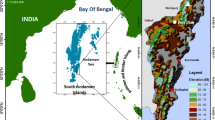Abstract
Ground-penetrating radar (GPR) was used to locate fractures and distinguish fracture properties at the laboratory and field scales. Laboratory studies were performed to define the effects of fractures on the GPR signal. In the laboratory, a fracture between two blocks of crystalline rock was filled with water or air, and the aperture of the fracture was varied from 0.75 to 10 cm. Air-filled and water-filled fractures were successfully distinguished on the basis of GPR signal polarity changes. Moreover, it was possible to estimate the fracture aperture when it was wider than the vertical resolution of the antenna. For instance, the resolution of a 800-MHz antenna enables the detection of 1-cm-wide water-filled openings. Armed with knowledge of the signal behavior at the laboratory scale, the apertures and the filling materials of fractures were also estimated in uncontrolled field conditions. These field studies were carried out in a dimension stone quarry of migmatitic granodiorite located in Southern Finland.









Similar content being viewed by others
References
Al-Qadi IL, Lahouar S (2004) Ground penetrating radar: state of the practice for pavement assessment. Mater Eval 62(7):759–763
Annan AP (2003) Subsurface imaging solutions. In: Ground penetrating radar: principles, procedures & applications. Sensors & Software Inc., Mississauga
Annan AP (2009) Electromagnetic principles of ground penetrating radar. In: Jol HM (ed) Ground penetrating radar: theory and applications. Elsevier, Amsterdam, pp 3–40
Cassidy NJ (2009) Electrical and magnetic properties of rock, soil and fluids. In: Jol HM (ed) Ground penetrating radar: theory and applications. Elsevier, Amsterdam, pp 41–72
Grandjean G, Gourry JC (1996) GPR data processing for 3D fracture mapping in a marble quarry (Thassos, Greece). J Appl Geophys 36:19–30. doi:10.1016/S0926-9851(96)00029-8
Grasmueck M (1996) 3-D ground-penetrating radar applied to fracture imaging in gneiss. Geophysics 61(4):1050–1064. doi:10.1190/1.1444026
Halleux L, Grégoire C (2002) Characterization of fractures by GPR in a mining environment. First Break 20(7):467–471
Hokkanen T, Korhonen K, Virtanen H, Laine EL (2007) Effects of the fracture water of bedrock on superconducting gravimeter data. Near Surf Geophys 5(2):133–139. doi:10.3997/1873-0604.200602
Lai WL, Kind T, Wiggenhauser H (2011) Frequency-dependent dispersion of high-frequency radar wave in concrete. NDT&E Int 44:267–273. doi:10.1016/j.ndteint.2010.12.004
Lane JW, Buursink ML, Haeni FP, Versteeg RJ (2000) Evaluation of ground-penetrating radar to detect free-phase hydrocarbons in fractured rocks—results of numerical modeling and physical experiments. Ground Water 38(6):929–938. doi:10.1111/j.1745-6584.2000.tb00693.x
Luodes H (2008) Natural stone assessment with ground penetrating radar. Est J Earth Sci 57(3):149–155. doi:10.3176/earth.2008.3.03
Pérez-Gracia V, Di Capua D, Gonzáles-Drigo R, Pujades L (2009) Laboratory characterization of GPR antenna for high-resolution testing: radiation pattern and vertical resolution. NDT&E Int 42:336–344. doi:10.1016/j.ndteint.2008.12.007
Porsani JL, Sauck WA, Júnior AOS (2006) GPR for mapping fractures and as a guide for the extraction of ornamental granite from a quarry: a case study from southern Brazil. J Appl Geophys 58:177–187. doi:10.1016/j.jappgeo.2005.05.010
Prissang P, Hellä P, Lehtimäki T, Saksa P, Nummela J, Vuento A (2004) Identification of mineable blocks in dimension stone rock masses. In: Hardygora M, Paszkowska G, Sikora M (eds) Mine planning and equipment selection. Taylor & Francis, London, pp 69–74
Rial FI, Pereira M, Lorenzo H, Arias P, Novo A (2009) Resolution of GPR bowtie antennas: an experimental approach. J Appl Geophys 67:367–373. doi:10.1016/j.jappgeo.2008.05.003
Sandmeier KJ (1998–2011) Reflexw, version 6.0. WindowsTM 9x/NT/2000/XP/7-program for the processing of seismic, acoustic or electromagnetic reflection, refraction and transmission data. K.J. Sandmeier, Karlsruhe
Acknowledgments
The authors are grateful to Docent Olavi Selonen at Åbo Akademi and Palin Granit Oy for providing the rock blocks. This study was financed by the Finnish Research Programme on Nuclear Waste Management and the Finnish Foundation for Technology Promotion.
Author information
Authors and Affiliations
Corresponding author
Rights and permissions
About this article
Cite this article
Markovaara-Koivisto, M., Hokkanen, T. & Huuskonen-Snicker, E. The effect of fracture aperture and filling material on GPR signal. Bull Eng Geol Environ 73, 815–823 (2014). https://doi.org/10.1007/s10064-013-0566-4
Received:
Accepted:
Published:
Issue Date:
DOI: https://doi.org/10.1007/s10064-013-0566-4




